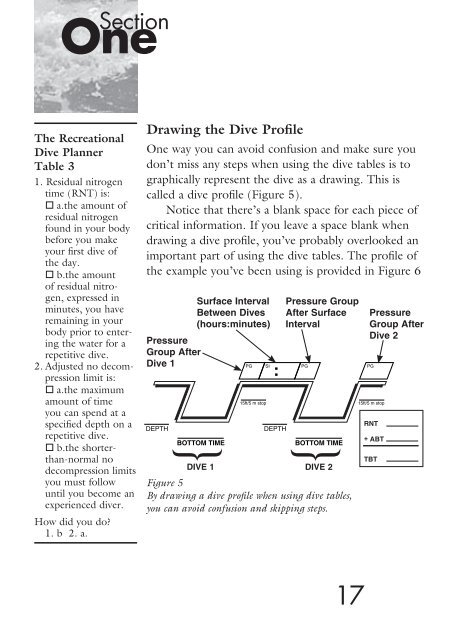Recreational Dive Planner - Padi
Recreational Dive Planner - Padi
Recreational Dive Planner - Padi
Create successful ePaper yourself
Turn your PDF publications into a flip-book with our unique Google optimized e-Paper software.
One<br />
Section<br />
The <strong>Recreational</strong><br />
<strong>Dive</strong> <strong>Planner</strong><br />
Table 3<br />
1. Residual nitrogen<br />
time (RNT) is:<br />
a.the amount of<br />
residual nitrogen<br />
found in your body<br />
before you make<br />
your first dive of<br />
the day.<br />
b.the amount<br />
of residual nitrogen,<br />
expressed in<br />
minutes, you have<br />
remaining in your<br />
body prior to entering<br />
the water for a<br />
repetitive dive.<br />
2. Adjusted no decompression<br />
limit is:<br />
a.the maximum<br />
amount of time<br />
you can spend at a<br />
specified depth on a<br />
repetitive dive.<br />
b.the shorterthan-normal<br />
no<br />
decompression limits<br />
you must follow<br />
until you become an<br />
experienced diver.<br />
How did you do?<br />
1. b 2. a.<br />
Drawing the <strong>Dive</strong> Profile<br />
One way you can avoid confusion and make sure you<br />
don’t miss any steps when using the dive tables is to<br />
graphically represent the dive as a drawing. This is<br />
called a dive profile (Figure 5).<br />
Notice that there’s a blank space for each piece of<br />
critical information. If you leave a space blank when<br />
drawing a dive profile, you’ve probably overlooked an<br />
important part of using the dive tables. The profile of<br />
the example you’ve been using is provided in Figure 6<br />
Pressure<br />
Group After<br />
<strong>Dive</strong> 1<br />
DEPTH<br />
Surface Interval<br />
Between <strong>Dive</strong>s<br />
(hours:minutes)<br />
PG SI PG<br />
:<br />
15ft/5 m stop<br />
DEPTH<br />
Pressure Group<br />
After Surface<br />
Interval<br />
BOTTOM TIME<br />
BOTTOM TIME }DIVE 1<br />
}DIVE 2<br />
Figure 5<br />
By drawing a dive profile when using dive tables,<br />
you can avoid confusion and skipping steps.<br />
Pressure<br />
Group After<br />
<strong>Dive</strong> 2<br />
PG<br />
15ft/5 m stop<br />
RNT<br />
+ ABT<br />
TBT<br />
17


